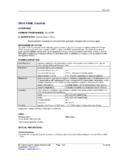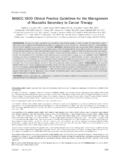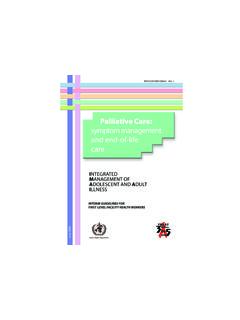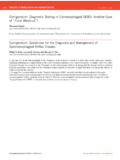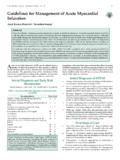Transcription of Symptom Management Guidelines: FEVER AND …
1 Symptom Management guidelines : FEVER AND neutropenia Definition FEVER : A single oral temperature of C (101 F) OR a temperature 38 C ( F) which lasts more than 1h neutropenia : An abnormally low number of neutrophils in the blood (ANC < X 109/L). The lower the neutrophil count, the greater the risk of infection Febrile neutropenia : FEVER and neutropenia Contributing Factors of neutropenia Cancer Related & Cancer Treatment Related Chemotherapy agents Monoclonal antibodies ( alemtuzumab) Extensive radiation to bone marrow ( pelvis, legs, and sternum) Stem cell transplants - at risk for severe, prolonged neutropenia Cancers that affect bone marrow ( lymphoma, leukemia or myeloma)
2 Solid tumors Febrile neutropenia in previous course of therapy Medications that induce neutropenia Antibiotics, antifungals, antimalarials Anticonvulsants, anti-inflammatories, antithyroid Cardiovascular agents, diuretics Gastrointestinal agents, immunosuppressants Phenothiazines, psychotropic drugs Co-morbidities Autoimmune diseases AIDS Hypersplenism Aplastic anemia Congestive heart failure Diabetes Cerebrovascular disease Tuberculosis Other Age 65 years Ethnic groups known to have a slightly lower ANC ( African Americans, Yemenite Jews, Ethiopians and certain Arabs) Pre-existing infections ( bacterial, viral, fungal, rickettsial, protozoal) Vitamin deficiencies ( vitamin B12, folate, copper); albumin level < 35 g/L; dehydration Hemodialysis, hypotension Recent exposures: travel, blood product administration Causative Factors of Infection in Patients with neutropenia Factors Related to Infection Immunosuppression.
3 Herpes Simplex Virus (HSV) reactivation in immunocompromised patients may be as high as 75% Prior infection and /or antibiotic use in last 90 days Chemotherapy- induced mucositis Presence of open wounds, catheters or drains Obstruction of the lymphatic system, biliary tract, bronchial, gastrointestinal or urinary systems by tumours or secondary to surgical procedures Graft versus host disease - may be at higher risk of developing fungal infections up to 6 months after transplant Potential exposure to pathogens during hospital stay Consequences Febrile neutropenia is considered an ONCOLOGICAL EMERGENCY which if left untreated, can quickly lead to sepsis, acute respiratory distress syndrome and/or septic shock See Appendix A Severe or prolonged neutropenia increases patient risk of infection (moderate risk: 7-10 days; high risk: >10days) Chemotherapy dose delays, reductions, or discontinuation of treatment The information contained in these documents is a statement of consensus of BC Cancer Agency professionals regarding their views of currently accepted approaches to treatment.
4 Any clinician seeking to apply or consult these documents is expected to use independent medical judgement in the context of individual clinical circumstances to determine any patient's care or treatment. Use of these documents is at your own risk and is subject to BC Cancer Agency's terms of use, available at Page 1 of 6 Focused Health Assessment GENERAL ASSESSMENT Symptom ASSESSMENT PHYSICAL ASSESSMENT Contact & General Information Physician name oncologist, family physician Pharmacy Home health care Other health care providers Allergies Consider Causative Factors Cancer diagnosis and treatment(s) note type and date of last treatment Post BMT Medical history - Recent infections, antibiotic therapy - Recent reports of diarrhea, constipation, vomiting, dysphagia, urinary symptoms Medication profile Review recent lab, diagnostic reports Normal Refer to pretreatment nursing or oncology assessment Onset When did symptoms begin?
5 Provoking / Palliating What makes it better? Worse? Quality (in last 24 hours) Can you describe your symptoms? What is your temperature? For how long? Region / Radiation Where are your symptoms? Vital Signs Frequency as clinically indicated. If severe neutropenia , presence of FEVER or infection then every 4 hours and prn * Special Consideration* High Risk Indicators Requiring Medical Attention such as: Recent chemotherapy/radiation regimen of high risk for febrile neutropenia Prior febrile neutropenia Post BMT FEVER , chills, rigors Recent or current infection Poor performance status Change in mental status Diarrhea, cough, dyspnea, chest or abdominal pain, headache, stiff neck, rash Age > 65 Potential for infection (Central vascular devices, IV lines, drains and catheters, prosthetic devices ( cardiac valves) Severity / Other Symptoms Have you been experiencing any other symptoms such as.)
6 Chills, sweating Shortness of breath Cough, with sputum (colour?) Fatigue or feeling unwell Mouth sores or sore throat Urination (Burning, urgency, frequency) Vaginal discharge, itching Constipation/diarrhea? Any areas of redness/ swelling/pain? Recent blood transfusion Recent travel or exposure to sick individuals Treatment Using any antipyretics? If so, what type? Any other medications or treatments? ( anti-diarrheas, granulocyte colony-stimulating factors) Understanding / Impact on You How much are you eating or drinking? What do you believe is causing these symptoms? How is this affecting you? Systems Assessment Presence of shaking (rigors), chills, diaphoresis level of consciousness and orientation skin and oral mucosa for signs of infection Note any areas of redness, swelling, pain, warmth, impaired skin integrity, exudate Respiratory tract.
7 Respiration note ease, presence of adventitious sounds Cough note quality of phlegm, duration of cough or phlegm Sinuses congestion, tenderness, unilateral eye tearing or facial swelling, bleeding, periorbital cellulitis Nares ulcerations, drainage Drains and catheters ( central vascular device, bladder catheters) for function and signs of infection The information contained in these documents is a statement of consensus of BC Cancer Agency professionals regarding their views of currently accepted approaches to treatment. Any clinician seeking to apply or consult these documents is expected to use independent medical judgement in the context of individual clinical circumstances to determine any patient's care or treatment.
8 Use of these documents is at your own risk and is subject to BC Cancer Agency's terms of use, available at Page 2 of 6 FEBRILE neutropenia GRADING SCALE (Adapted NCI CTCAE Version ) Normal GRADE 1 (Mild) GRADE 2 (Moderate) GRADE 3 (Severe) GRADE 4 (Life threatening) Asymptomatic __ __ ANC < X 109/L with a single temperature of > C (101 F) OR a sustained temperature of 38 C ( F) for more than 1h Lif e-threatening consequences; urgent intervention indicated *Step-Up Approach to Symptom Management : Interventions Should Be Based On Current Grade Level and Include Lower Level Grade Interventions As Appropriate NORMAL NON URGENT: Prevention, Support, teaching & follow-up care as required Patient Care and Assessment Review cancer treatment and potential for neutropenia Refer to specific chemotherapy protocol for direction.
9 Not all patients with neutropenia exhibit a FEVER in the presence of an infection ( elderly, patients on corticosteroids)- assess for other signs of clinical deterioration ( hypothermia, hypotension, confusion) Recommendations for Prevention of Infection Maintaining adequate hydration and nutrition incorporating protein, vitamin B and C during treatment assists with maintaining skin integrity. Use an electric shaver rather than a razor for shaving. Have a flu shot and other immunizations as indicated Vaccination should be at least 2 weeks before receiving chemotherapy or immunosuppressive therapy. Patients having chemotherapy or radiation therapy should not receive live attenuated vaccines unless instructed by physician.
10 Inform dentist of current treatment prior to dental treatment and to limit treatment, if possible, to periods when counts will be higher (within a couple of days of chemotherapy treatment). Use a water-soluble lubricant during intercourse. If unsure of partner disease status, use lubricated condoms to protect against sexually transmitted diseases. If severely neutropenic, check with health care team to determine if intercourse should be avoided during this time. Avoid handling pet feces, including fish tanks, bird cages and cat litter boxes Avoid large crowds or anyone with signs of infection ( chicken pox, measles, cold, flu, and shingles) especially during nadir (typically 7 to 14 days). Avoid constipation and straining to prevent trauma to rectal tissue.









